Sections
Years ago, humans were imagining a magical world were ability to interact with different machines through thought was possible. Most people believed this magical world as myths and fiction stories. But now, with the advancement in neuroscience and brain imaging technology a great interest has been shown by the scientists to turn this fiction into reality. As a result, a new window has been opened up were the ability to interface directly with the brain is possible through Brain Computer Interface (BCI).
As an upcoming technology, BCI helps to convey human intentions to the world directly from their interior thoughts. It is considered to be one of the enchanting breakthroughs for the human society since it can benefit the medical world, technical industry and even the military sector. Today, BCI holds the promise of restoring sight for the blind, hearing to the deaf and the return of normal functionality to the paralyzed. Even though it seems a miracle, through BCI it is possible and now it is been practiced on many human beings.

![]()
What is BCI?
BCI is a method by which the brain signals are used to control an external device. In simple terms, this technology acts as an interfacing platform between the brain and a device. Today, BCI is popularly known by the names Brain Machine Interface (BMI), Synthetic Telepathy Interface (SMI), Direct Neural Interface (DNI), or by Mind-Machine Interface (MMI).
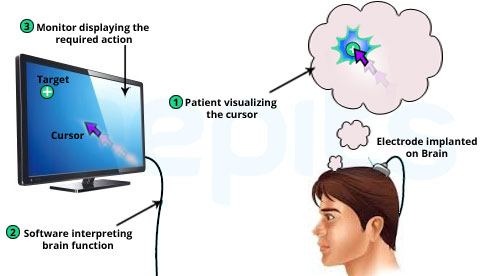
Generally, a BCI is a computer-based system that acquires brain signals. After acquiring the signals, it analyzes and translates them into commands that are relayed to an output device to carry out a desired action. Thus, BCIs do not use the brains normal output pathways of nerves and muscles. This definition limits the term BCI to systems that measure and use signals produced by the central nervous system (CNS). For example, a voice or muscle-activated communication system is not a BCI. Also, brain imaging technologies like EEG (Electroencephalography), ECOG (Electrocorticography), fMRI (functional Magnetic Resonance), and MEG (Magnetoencephalography) alone is not a BCI because it only records brain signals but does not generate an output that acts on the users environment. Also, Brain Computer Interface (BCI) do not read the minds in the sense of extracting information from unsuspecting or unwilling users but enable users to act on the world by using brain signals rather than muscles. The user and the BCI generally work together.
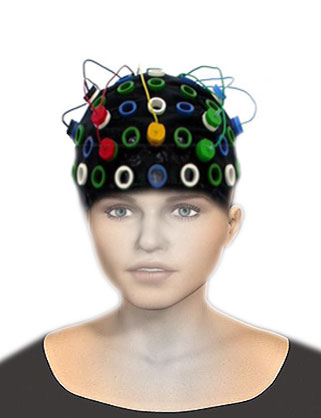

Research work on Brain Computer Interface (BCI) began early in the year 1970 itself. This research work was started at the University of California Los Angeles (UCLA) under the permission from the National Science Foundation after a contract from DARPA. Thanks to the development of brain imaging technologies like EEG, ECOG fMRI, MEG etc. This is because they were one of the major milestones which helped the research workers to continue their work on BCI. At first, BCI work was carried on many animals and today it is tested on human beings too. Today, one of the major goal of BCI research is to develop applications that helps disabled people (suffering from brainstem stroke, spinal cord injury, blindness etc.) to communicate and interact with people and external environments.
A BCI system consists of three components: Signal or Data Acquisition, Signal Processing (Feature Extraction, Feature Translation), and Output Device. These components are controlled by a protocol which defines the timing for operation, signal processing details, nature of device commands and the performance.

Signal acquisition in a BCI helps in the measurement of brain signals using a sensor modality. The sensor is basically a device implanted in the brain usually multi-electrode arrays that records the signals directly related to the movement. The signals can be amplified to levels suitable for electronic processing. Also, they can be subjected to filtering to remove electrical noise or other undesirable signals. After amplification and filtering process, the signals can be digitized and transmitted to a computer.
Feature extraction in Brain Computer Interface (BCI) is the process of analyzing the digital signals to distinguish signal characteristics and represent them in a compact form suitable for translation into output commands. These features been extracted should have good correlations with the users intent.
Resulting signal features are passed to the feature translation algorithm, which converts the features into the commands for the output device (i.e., commands that accomplish the users need).
The commands from the feature translation algorithm operate the external device of the Brain Computer Interface (BCI), providing functions such as cursor control, letter selection, robotic arm operation etc. The device operation then provides feedback to the user finally, thus completing the closed loop of Brain Computer Interface(BCI).
Several types of brain-computer interface are reported. The basic purpose of these types is to intercept the electrical signals that pass between neurons in the brain and translate them to a signal sensible by external devices.

Invasive BCIs generally use electrodes (sensors) that are implanted directly into the grey matter of the brain during neurosurgery. Since they lie in the grey matter of the brain, invasive BCI produce the highest quality signals. But, the main disadvantage is that they are prone to scar tissue build-up, causing the signal to become weaker, as the body reacts to a foreign object (electrodes) in the brain. Today, invasive BCI targets, mainly the blind and the paralyzed patients. One of the first scientists to produce a working brain interface to restore visual sight was William Dobelle. The system included cameras mounted on glasses to send signals to the implant. Philip Kennedy and Roy Bakay Emory University researchers in Atlanta were the first to implement the brain implant in a human which helped to produce signals of high quality to simulate movement. The recent BrainGate Neural Interface System is another popular invasive BCI.
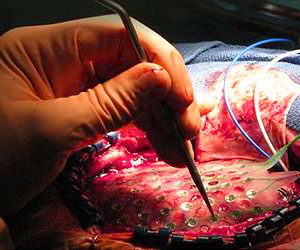
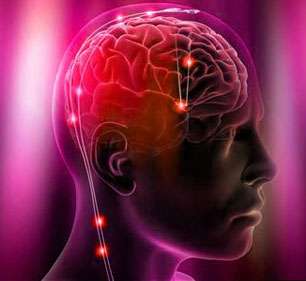

This BCI use electrodes that are mainly implanted in the skull and exterior to the brain. Better resolution, good frequency range and high quality signals are some of its advantages. Here ECoG measures the electrical activity of the brain taken from beneath the skull. The partially invasive BCI electrodes are embedded in a thin plastic pad that is placed above the cortex, beneath the dura mater (thick membrane that surrounds the brain and spinal cord). Today, research on Light Reactive Imaging BCI devices is taking place. These BCI devices generally involve implanting a laser inside the skull. Researchers of Carleton University, Canada believed that the same interface of Light Reactive Imaging BCI could form the basis of a mind controlled password system.
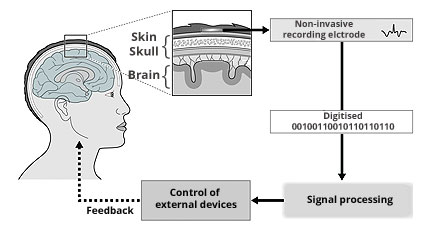
Non-invasive BCI has minimum signal clarity but it is considered to be the safest. This type of BCI has been found to be successful in giving a patient the ability to move muscle implants. In the non-invasive technique, medical scanning devices or sensors are mounted on caps or headbands and they help to read the brain signals. Less signal clarity in non-invasive BCIs is because; the electrodes cannot be placed directly on the desired part of the brain.
EEG Based Non-Invasive BCI: EEG generally provides the recording through the electrodes placed on the scalp with a conductive gel or paste. Number of electrodes used by the current EEG BCI is within a range of few to 100 electrodes. Since electrode gel can dry out and also the setting up procedure has to be repeated before each session of BCI use, EEG-based BCI are not convenient. As a possible solution, dry electrode arrays can be used. To get better recordings, scientists place the electrodes accurately by following the International 10-20 System. Here' F' represents Frontal Lobe, 'P' represents Parietal Lobe, 'C' represents Central Sulcus and 'O' and 'T' represents the Occipital Lobe and Temporal Lobe of the brain structure respectively.

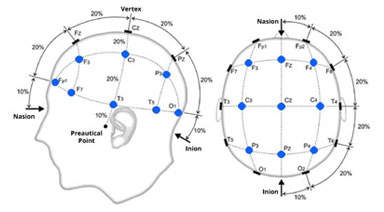
Dry Electrode Array Based EEG Non-Invasive BCI: To solve the problem of the above EEG based non-invasive BCI, this BCI device uses a dry electrode. The major advantages of such electrodes are; no electrolyte is used, no skin preparation, significantly reduced sensor size and compatibility with EEG monitoring systems.
Prosthesis Control Non-Invasive BCI: Today brain-control of prosthetic upper and lower in people with paralysis is possible. Gert Pfurtscheller of Graz University of Technology and colleagues came up with the prosthesis control system for the disabled.
Today, MEG and fMRI are being used as brain signal recording techniques for non-invasive BCI widely. fMRI usually measures small changes in the blood oxygenation level dependent signals associated with the brains cortical activation. Controlling robot arms and playing Pong in real time are some recent fMRI BCI experiments. MEG detects magnetic fields within the brain.
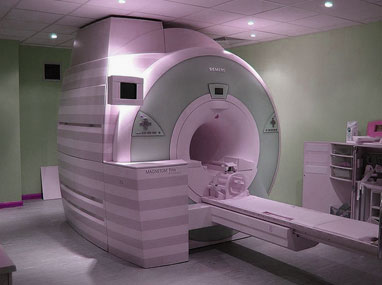
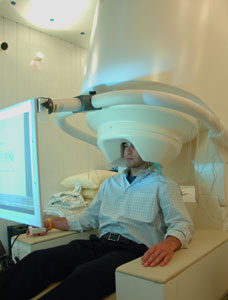
Animal BCI research started from 1970s and is still continuing to bring out great advancements in Brain Computer Interface (BCI)Technology. At first, the BCI research took place with animals like monkeys and rats. This is because monkeys have better abilities and skills, making them ideal test subjects for BCI work. Some of the animal BCI results were; monkeys controlling computer cursors, commanding robotic arms, decoding neuronal firings to reproduce images seen by cats etc. Through animal BCI research work, many scientists came up with astonishing results which tempted them to perform Human BCI research. The biggest problem to Brain Computer Interface (BCI) at present is the lack of a sensor modal that provides accurate, safe and robust access to brain signals. It’s said that such a sensor will be developed for Brain Computer Interface (BCI) within the next twenty years.
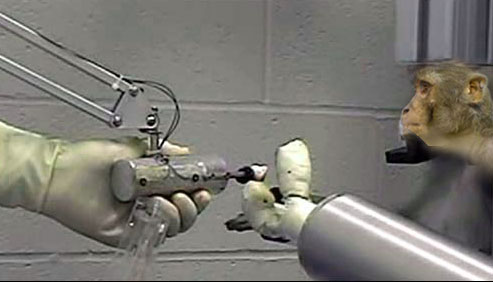
Commercial Viability
Though extensive research work is going on within Brain Computer Interface (BCI), only a minimum amount of products are available in the consumer market. High cost is one of the major reasons for their reduced popularity. Some of the BCI products or applications are given below.
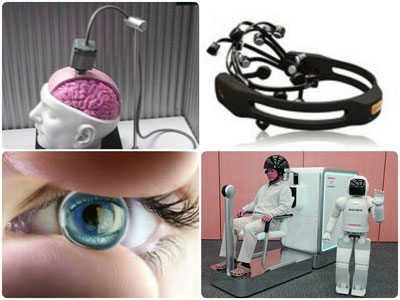
BrainGate Implant: Developed by Cyberkinetics and is the better brain implant for BCI systems.
Star Wars Science Force Trainer: This toy includes a headset which is wireless, a plastic tube with fan and ping pong ball. On concentrating the brain activity will turn up the fan and will blow a ping-pong ball up a tube.
Neural Impulse Actuator: This brain BCI mouse is marketed as a playing game product which allows controlling games with thoughts.
Mindset: This headset from NeuroSky is a Bluetooth BCI headset.
EPOC: Neurogaming is gaining popularity today as a Brain Computer Interface(BCI). As a proof, Emotiv has bought up an EPOC headset that can detect expressions, emotions, thoughts and it will track the players excitement and allow manipulation of objects on the screen through thought.
Bionic Eye: It is an artificial retina. The bionic eye is developed by Second Sight Medical Products.
Honda Asimo Control: ASIMO could do jobs that are dangerous for humans to do. Today, ASIMO robots are put to work in Japanese businesses to work as receptionist and welcoming guests.
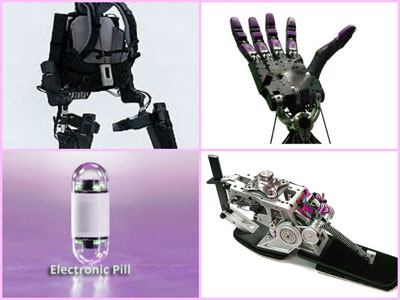
Deep Brain Stimulator: Product from Medtronic used to treat Epilepsy, Depression, Dystonia etc.
Robotic Foot: Manufactured by Osscur is helpful for the disabled people.
PillCam: A capsule with a camera which is swallowable. This product is good for endoscopy. Given Imaging is the manufacturer of it.
Artificial Arm: Developed by DEKA and Development Corporation, is good for paralyzed patients.
Powered Exoskeleton: It is a robotic exoskeleton, which helps old people for walking and lifting objects.
Wireless BCI Systems: It consist of clip-on electrode holders for dry MEMS, a DAQ unit and wireless transmission circuitry. These systems are really good as a Brain Computer Interface (BCI).
Mind Reader Google Glass: Combining Google Glass with BCI headsets.
Some of the good advantages of BCI are direct communication between brain and devices, better living for paralyzed people etc. While the disadvantages of BCI are; ill effects in the brain due to viral attacks, requiring excessive training for proper usage, high cost, slow speed, lack of better sensor modality, invasive BCIs are risky since it requires neurosurgery etc.
As the coming step of technological advancement, many research workers and scientists are trying to bring out wide variety of BCI applications useful for the society. Coming years, we can make BCI restore and augment human functions thereby improving quality of living. Some applications like flying an aeroplane just by thinking, a blind driving a vehicle etc. will be coming to a reality. In the medical sector, research workers are trying to bring out miniaturized equipments and introduction of wireless BCI. It’s said that in the coming future, we can replace the robotic devices and directly bypass the signals to the nerves in the damaged part of the brain, thereby allowing the paralyzed patient to move their body. Last but not the least, development in BCI can bring out drastic and attractive changes to the society.
Sections